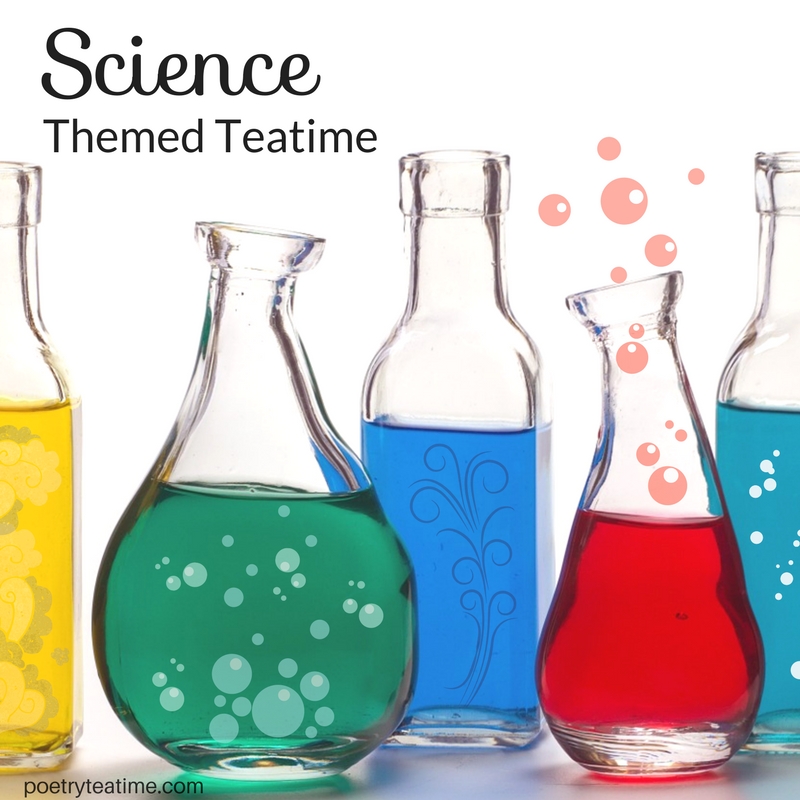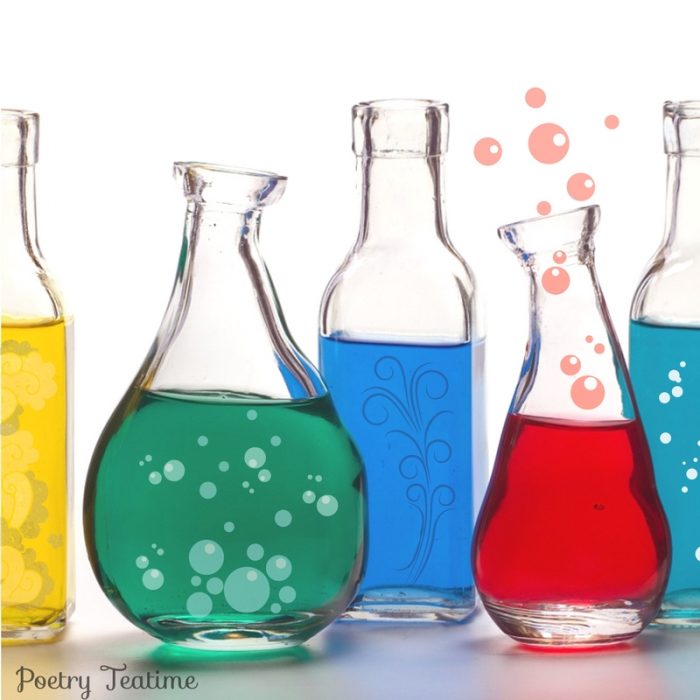Spring is in the air, which means trees are starting to bud, bugs are beginning to hop around in the new grass, and birds are busily chirping away! This is the perfect time of year for a science themed teatime. Join us today as we explore color-changing tea, DNA decorations, zany experiments, and more ways to stir some science into your Poetry Teatime!
[This post contains Amazon affiliate links. When you click on those links to make purchases,
Poetry Teatime receives compensation at no extra cost to you. Thank you!]
To begin today’s teatime, imagine yourself on a long walk across some muddy fields. Your boots squelch. A fresh spring breeze carries the sound of lambs bleating in the next field. You go around a bend in the path and suddenly, spread out at your feet, you find a carpet of yellow daffodils bobbing up and down in the breeze.
That scene is exactly what William Wordsworth describes in his lovely poem “I Wandered Lonely as a Cloud.” Let’s begin by reading it now.
From “I Wandered Lonely as a Cloud”
By William Wordsworth
I wandered lonely as a Cloud
That floats on high o’er Vales and Hills,
When all at once I saw a crowd,
A host of golden Daffodils;
Beside the Lake, beneath the trees,
Fluttering and dancing in the breeze.
Continuous as the stars that shine
And twinkle on the Milky Way,
They stretched in never-ending line
Along the margin of a bay:
Ten thousand saw I at a glance,
Tossing their heads in sprightly dance.
Part of the fun of poetry is how it draws our attention to the world around us. Wordsworth’s descriptions transport us to that field full of bright flowers shining in the sunlight!
How does Wordsworth’s poem relate to science? Scientists are like poets: they pay close attention to nature. They observe using their five senses. They compare what they see to what they already know, just like Wordsworth compares the daffodils to stars twinkling in the Milky Way.
In today’s teatime, you’ll have the chance to follow in the footsteps of both poets and scientists. Get ready to brew some experimental tea, learn about molecular structures, and construct a DNA chain. Now let’s dive right in!
Scientific Food & Drinks
Color-changing tea: Did you know that some teas change color? The butterfly pea flower tea, originally from Thailand, starts out a deep blue but can transform depending on the pH level of ingredients added to it. Squeeze in a few drops of lemon and watch it turn pink, then experiment with other things to add! You can even make predictions based on the acidity of the substance you’re adding. Find it at Whole Foods or here on Amazon.
Mad Scientist potion: This simple drink uses just three ingredients to create a mysterious bubbling brew. One of the ingredients is dry ice, but if you can find it near you, the results are definitely worth it! Follow the directions here at Our Best Bites.
Molecular grapes: Grab some toothpicks and grapes (or marshmallows) and craft edible molecules! Use images of molecular structures for reference. Try simpler ones like H20 (water) or CH4 (methane), or go for something more challenging, like C6H12O6 (glucose).
Science-Themed Decorations
Dollar Store critters: Now don’t get too worried--we’re talking about plastic critters here! The Dollar Store is a fun place to find cheap decorations, especially since they change their products with each season. Scoop up a handful of (fake) bugs and invite them to your teatime today!
DNA chain streamers: Want the simple way to create DNA? Get a roll of streamers and four different colored markers. Draw two-colored lines across the streamers to represent the alternating base pairs of adenine and thymine, guanine and cytosine. Once you’ve finished coloring, twist the streamers and hang them up! For a more detailed model using tape and straws, check out this step-by-step guide on Toys from Trash.
Experimental Activities
Nature walk: What would a science-themed teatime be without a nature walk? Bundle up if it’s still chilly outside where you live. You can collect objects like rocks and twigs to study more carefully at home, or take a camera along to snap pictures of your favorite scenes. Be sure to pause and smell the air and listen to life around you!
Play a science game: This game is great to get you up and moving! Make sure you’re somewhere with plenty of space. One person shouts out the three states of matter and everyone has to move/freeze according to that state: liquid (walk around), solid/ice (freeze!), and gas/steam (run wild!). For an explanation of the game and the science behind it, check out this post on One Project Closer.
Wild experiments: What’s a science teatime without some crazy scientific experiments to try? This list of 35 science experiments compiled by Architecture & Design ranges from the explosive to the colorful, icy, and just plain zany! Pick your favorites and add them to your teatime lineup!
Science & Poetry Books
Spectacular Science: A Book of Poems, by Lee Bennett Hopkins
Ordinary Things: Poems from a Walk in Early Spring, by Ralph Fletcher
Scien-Trickery: Riddles in Science, by J. Patrick Lewis
Vegetable Garden, by Douglas Florian
Footprints on the Roof: Poems about the Earth, by Marilyn Singer
Feathers: Poems about Birds, by Eileen Spinelli
Earthshake: Poems from the Ground Up, by Lisa Westberg Peters
Water Rolls, Water Rises: El Agua Reuda, El Agua Sube, by Pat Mora (bilingual English-Spanish poetry)
Creatures of Earth, Sea, and Sky, by Georgia Heard
Insectlopedia, by Douglas Florian
Science Verse, by John Scieszka



